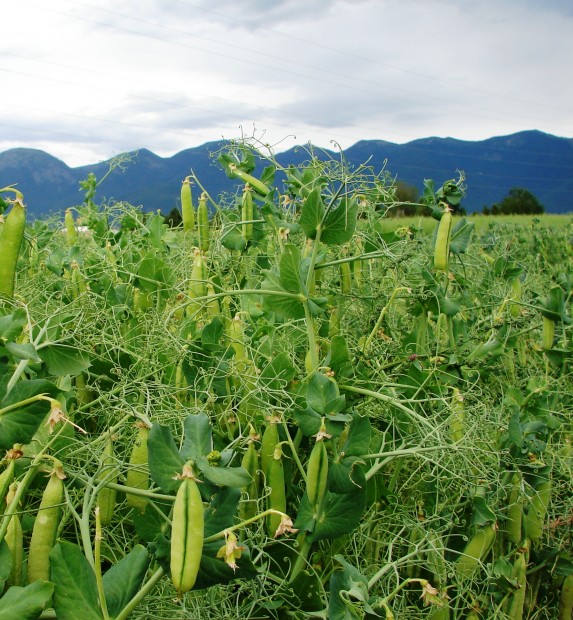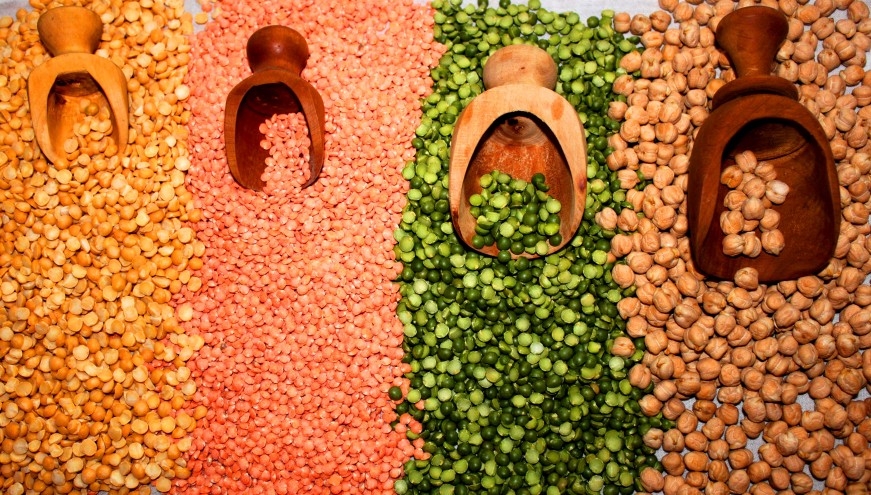Gaining Popularity with North Central Agriculture
Written by Suzanne Waring
The United Nations declared 2016 the International Year of Pulses, and North Central Montana has chosen to be right in the middle of the festivities. Pulse growers, elevator managers/owners, and consumers from this region began celebrating on January 6 at Columbia Grain, Inc., by participating in a Pulse Feast where all of the dishes contained pulses—even dessert. As Montanans celebrated, others throughout the world were also taking part in Pulse Feasts. We pause to wonder exactly the reason for the excitement occurring throughout the world and here in Montana.
North Central Montana Farmers Are Enthusiastic about Using Pulses in the Crop Rotation Cycle. Gradually over the last ten years, many farmers in the 13 counties of North Central Montana have added pulses, which are low-fat legumes harvested for their dry seed, to the list of crops that they grow. Among the 12 primary pulse varieties, the cool-season pulses being grown in this region are mainly field peas, lentils, and chickpeas (garbanzos). While the northeast corner of Montana is the archetype of pulse production in the state with growers in Sheridan County using 136,260 acres for pulse production, farmers in the north-central counties of Hill and Toole together raised over 80,000 acres of pulses in 2015.
Pulse crops have become popular for replacing the fallow year in wheat production because pulses fix nitrogen from the air into the soil and improve soil quality. These legumes have been grown and tilled under as a “green manure.” At other times, the crop has been used as forage for livestock, but in recent years, because of the huge market, the dry pulse seeds have been harvested. From 2010 to 2015 pea production in North Central Montana, which now produces 31.5 percent of the peas harvested in the state, has gradually increased from 65 million pounds to 245 million pounds. The practice of continuous cropping on a parcel of land provides income for the farmer every year instead of every other year.
Planting pulses has additional advantages. They are sustainable, which means that they have the ability to meet the needs of present production without compromising the ability for future crops to be successful. Eric Doheny, a pulse production farmer from Dutton, said, “It is fun to watch peas grow, but the farmer needs to pay attention to the chemical history of the land where pulses are being planted.” Very little fertilizer is needed for pulse crops, and they break insect and soil disease cycles for wheat and barley. They use very little moisture, and because they mature before the hot, dry weeks of the growing season, they are often successful when other crops are not. The rotational benefits improve yield and quality in wheat and barley the next year.
For these reasons, pulse production growth in North Central Montana will continue to grow. In 2014, this region produced 2.67 million acres of wheat while only 158,700 acres of peas were planted—6 percent of wheat acreage. Neil Doty, Ph.D. and noted consultant on pulses, wrote, “Farmers…will become more aware of the potential for higher on-farm net returns from pea production and are projected to increasingly adopt the practice of raising peas in their wheat rotation.”

Field Peas growing on a farm in Montana. Photo courtesy of Peggy Stringer
“To support this crop, researchers in the College of Agriculture at Montana State University are working at identifying the right varieties for climate, soils, and season found in Montana,” said Barry Jacobsen, Ph. D. and Associate Director, Montana Agricultural Experiment Station and Head of the Department of Research Centers at Montana State University. He sees the increased production of pulses will not only increase income for farmers but will also generate new jobs in areas of creation and production of auxiliary tools, such as sensors and software for pulses; processing facilities; consultants; and on-farm jobs.
North Central Montana Consolidators are Positioning Themselves for a Great Future
As of this year Montana is ranked first in the production of cool-season pulse crops. Elevator owners—or what Doty called consolidators—in the region are exuberant over having an additional commodity to buy and resell. “Presently we export pulses mostly to China, Pakistan, Bangladesh, and India,” said Jeff Van Pevenage, Senior Vice President and Regional Manager of Columbia Grain, Inc. “Pulses are often the main source of protein for these populations.” While Columbia Grain, with regional headquarters in Great Falls, is the major exporter of pulses from this region, other consolidators and exporters are Belle Pulses in Hingham, JM Grain in Great Falls, Commercial Lynks in Cut Bank and Global Argo in Chester.
Primary and secondary food processors that purchase pulses from consolidators are usually located in foreign markets; however, food, feed, and pet food manufacturers in the United States are increasingly using pulses, especially dry pea components, in their products. Some consolidators in Montana are able to clean, grade, split, polish, and package mainly peas. “We have seen increased demand for peas milled into flour from our customers,” said Greg Thayer, President of Montana Milling.
The next step in refining pulses is the process of fractionation that isolates the components of peas so that they can be used in commercial products. Once peas are fractionated, the sought-after protein, sugar/starch, and fiber are separately available. The protein fraction has over 50 percent protein; the glycemic sugar/starch fraction, over 75 percent starch; and the fiber fraction content, around 87 percent fiber. More sophisticated processes can drive these numbers even higher.
Highly refined fractionation-process facilities are presently located in North Dakota, Saskatchewan, Manitoba, France, Belgium, and China. Even with the high production of pulses in Montana, there is currently no fractionation plant located within the state.
This last year the Great Falls Development Authority commissioned Doty to write a business case study promoting the numerous factors conducive to building a Great Falls fractionation facility providing a high-quality product at a low cost. Positive factors are the region’s proximity to high-quality pulses, low cost of energy, adequate water, plentiful labor force, on-farm storage providing year-round access to pea commodity deliveries, industrial parks with transportation accommodations to the numerous plants that produce food products in the United States and abroad, and the success of area facilities already manufacturing intermediate industrial food products. Drawing on these advantages, Great Falls Development Authority is using the study to introduce Great Falls to those companies in a position to build a pulse fractionation facility.
North Central Montana Consumers Join Others in Enjoying Cuisine Containing Pulses
U. S. consumers are just now learning how to use pulses in cooking—beyond making soups and hummus. In the United State use of pulses for foodstuff has been presently growing at only 5 percent each year. “Animal food processors buy more pulses than facilities that produce food for humans. Because of the nutritional benefits, we need to turn that around starting with the International Year of Pulses,” said Van Pevenage.
Pulse flours and pulse fractionation powders made by primary processors are sold to secondary processors that use them as ingredients for commercial foodstuffs that eventually end up on the grocery shelf. These pulse ingredients are found in bakery items; snack chips and crackers; drink mixes; spreads, dips, and butters; meat-free protein products; and protein supplements. Including pulse products as ingredients in foodstuffs is definitely a positive step in food manufacturing.
Pulse components also apply directly to the major food marketplace trends, such as vegetarian, high vegetable protein, high fiber, gluten free, non-allergen, non-GMO, and low glycemic index value. Pulses provide an abundant amount of vitamins, especially the various B vitamins. They contain about twice the amount of protein found in whole grain cereals like wheat, oats, barley, and rice, and the high fiber content helps to decrease blood cholesterol levels and controls blood sugar levels. Pulse flours and powders, if not already, will soon be available in grocery stores to the family member who prepares home-cooked meals.
In this issue of SignatureMT, a variety of dishes using pulses is being highlighted for the reader to prepare, enjoy, and celebrate because peas, lentils, and chickpeas are so very good for you, and they are grown here in Montana.

